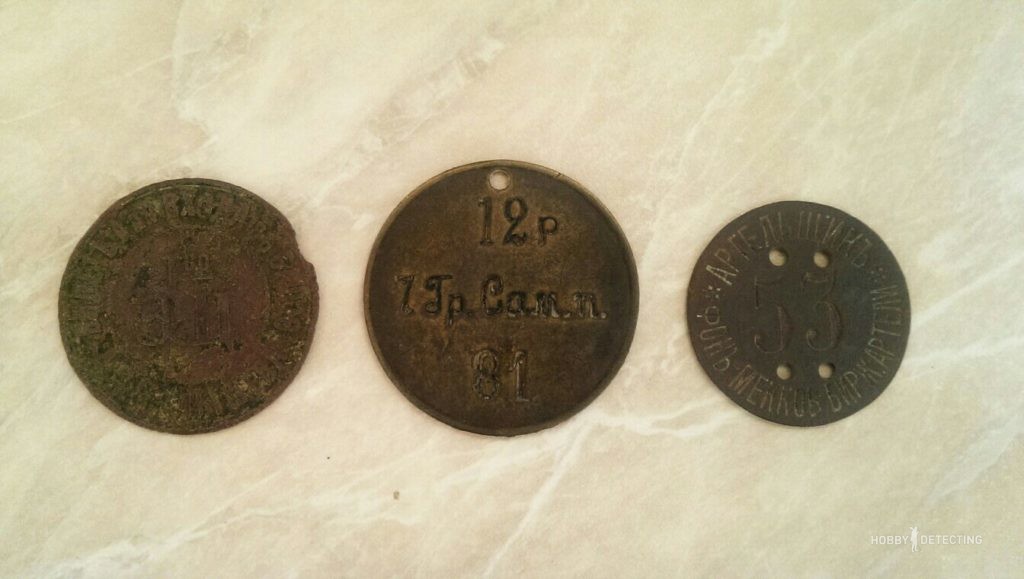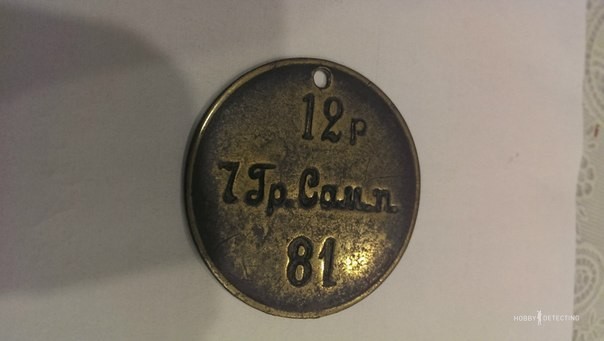THE HISTORY OF THREE TOKENS (IDENTIFICATION OF FINDS+)
In this article, I decided to tell you the story of three tokens found by chance by instrument search enthusiasts in the period from 2014 to 2016. All these finds are united by the same discovery area – Starozhilovsky district of the Ryazan region.

This topic is quite interesting, since many diggers come across similar tokens under the coil of a metal detector and end up in private collections.
BATH TOKEN
Содержание статьи:
Token “Ticket to enter the bathhouse A.N. Malysheva”. Partnership of the printed cotton manufactory “Emil Tsindel in Moscow”.

Bath token
Date of manufacture: late XIX – early XX centuries.
In the center of the token there is an inscription in two lines:
“T in E.C.” – short for “Partnership Emil Tsindel”.
A circular inscription in a rope and linear rim: “TICKET for ENTRANCE to the BATH *A.N. MALYSHEV*.”
All inscriptions are in relief. Reverse side: counter-relief.
Metal: copper.
Approximate price: 4000 rubles.
Location of discovery: Russia, Ryazan region, Starozhilovsky district, on the outskirts of the village of Gulynki.
In 1847, Emil Ivanovich Tsindel (1811-1874) founded the Emil Tsindel in Moscow Calico Printing Manufactory Partnership. The founders of this enterprise were also famous Moscow entrepreneurs: I.A. Lyamin, K.T. Soldatenkov, A.I. Khludov, as well as Trading houses L.I. Knop, Tsenkhera and K Malyutin with their sons. Ivan Karlovich Prove becomes the Chairman of the Board of the Partnership, and Kozma Terentyevich Soldatenkov becomes the Director of the Board. Since 1874, the board of the Emil Tsindel partnership was headed by Julius Ivanovich Tsindel. Since 1883, the director of the board of the Partnership was German Lyubimovich Steker, and since 1897 – Pavel Petrovich Voronin.
The company developed very quickly, and by the end of 1899, its own dyeing and mercerizing departments, a building for bleaching and printing fabrics, as well as a railway line for sending products were built. Subsequently, the factory had branches and warehouses not only in Moscow, Naro-Fominsk, Nizhny Novgorod, but also in the Chinese Sinanfu, Tashkent, Kokand and Khiva. The products of Emil Tsindel's factory were distinguished by their special elegance of design and surface finishing of fashionable cotton fabrics for dress and furniture fabrics. The art of drawing, engraving and coloring at this manufactory was at a very high level. Master artists and draftsmen professionally mastered the art of carefully elaborating individual elements of a drawing. When creating the designs, the tastes of various segments of society, their needs, and their idea of the beauty of the pattern were taken into account.
In 1895, E. Tsindel’s enterprise received the right to register a product label with Russian symbols. In Moscow, a department store and a house for employees are opened at the Partnership's factory, and the factory's products are widely advertised in various popular publications.
The Emil Tsindel in Moscow factory operated until 1915. In Soviet times, this textile industry enterprise in Moscow began to be called the “First Printing Factory.”
As for the found token itself, when studying the material about Emil Tsindel’s partnership, the following references to bathhouses came across: “The workers used the factory apartment, heating, and bathhouse for free…”. Moreover, the workers were instructed to “… pick up a metal bath badge from the factory office, which they present to the bathhouse superintendent every time they visit it.”
But Alexey Nikolaevich Malyshev, as of 1901, is mentioned as the owner of a bathhouse in Moscow on a street called “Shchipok”.
It turns out that such a street still exists today. Shchipok is a street in the Zamoskvorechye district of Moscow. Local historians associate the origin of this interesting street name with the fact that here, at the customs outpost, traders who came to Moscow with cartloads of goods were pinched (“groped”).
That is, the partnership of the calico manufactory “Emil Tsindel in Moscow” concluded with A.N. Malyshev signed an agreement to wash his hard workers in his bathhouse. How could this ticket to enter the bathhouse end up so far from Moscow in the Starozhilovsky district of the Ryazan region? Here everything is very simple. At the beginning of the 20th century, many people went to work in Moscow from nearby provinces. The token was in the pocket of one of the workers and was not used. Then the man came to his homeland, and lost him there.
DISMISSAL TOKEN
Discharge badge of a soldier of the tsarist army (12th company, 7th Grenadier Samogitsky regiment).

Dismissal badge
Date of manufacture: early 20th century.
In the center of the token there is an inscription in three lines:
“12 r 7 Gr.Sam.p. 81″.
The inscriptions are in relief. Reverse side: blank, smooth.
Metal: brass.
Approximate price: 6000-7000 rubles.
Place of discovery: Russia, Ryazan region, Starozhilovsky district, in a defunct village called Leznevo.
A discharge badge (token) is an item without which a serviceman’s leave would not be possible. Dismissal badges appeared in the RIA in 1902 and existed until 1917. The draft charter of 1902 in the section “Dismissal of lower ranks from the yard and on vacation” stated: Lower ranks dismissed for one day or more are considered to be on vacation and receive vacation tickets. If dismissed for less than a day, they are considered dismissed from the yard and receive: those dismissed before roll call – a dismissal sign, those fired before late – a dismissal note.
Each company (squadron, battery) had as many discharge marks as there were lower ranks on the unit list. All dismissal signs were stored in special boxes or lockers, the keys to which were kept by the duty officer of the company (squadron, battery).
Lower ranks, before leaving the territory of the unit, came to the duty officer of the company (squadron, battery), who inspected their uniform and whether they were neatly dressed and gave them dismissal signs or dismissal notes. Returning back, the lower ranks handed over their dismissal signs or dismissal notes to the duty officer, who noted in a special book the time of arrival of the dismissed and, if necessary, made other notes. This procedure has remained virtually unchanged for more than a hundred years in modern armed forces. Perhaps the dismissal badges were replaced by a dismissal note paired with a military ID.
In this particular case, we see the discharge badge numbered 81 of the tsarist army soldier of the 12th company of the 7th Samogit Grenadier Regiment of Adjutant General Count Totleben.
The 7th Samogit Grenadier Regiment of Adjutant General Count Totleben quite often took part in hostilities in the western direction. Years of existence of the regiment: 1797 – 1918. Dislocation: until 1856 – Mologa, Yaroslavl province; until 1857 – the city of Murom, Vladimir province; until 1904 – Moscow, Pokrovsky barracks. On March 12, 1918, by order No. 41 of the Grenadier Corps, all units of the corps were disbanded.
ARTELMAN'S TOKEN
Job badge of artel worker No. 53 of the von Meckow stock artel.

Artel worker's badge
Date of manufacture: late 19th century.
In the center of the token are the numbers: “53”.
Circular inscription: “ARTELSHCHIK *FON-MEKKOV EXCHANGE ARTELI*.”
The inscriptions are in relief. Reverse side: blank, smooth.
Metal: copper.
Approximate price: 5000 rubles.
Place of discovery: Russia, Ryazan region, Starozhilovsky district, in a defunct village called Dolmatovo.
The von Meck Exchange Artel, belonging to the famous dynasty of “railway kings,” was formed in Moscow by 1889 (the so-called “House of the von Meck Exchange Artel” has survived to this day and is located at the address: Moscow, Lesnaya St., no. 59). The Von Meck Exchange Artel was engaged in exchange transactions with shares of railways and heavy metallurgy. The founder of this exchange artel was Karl Fedorovich von Meck, one of the pioneers of private railway construction in Russia, who laid the foundation for the family’s multimillion-dollar fortune. It should be noted that philanthropist Pavel Grigorievich von Derviz and his colleague engineer Karl Fedorovich von Meck earned their enormous fortune precisely on the construction of the Moscow-Ryazan and Ryazan-Kozlovskaya railways. Here, in fact, lies the clue to the location where our token was found, since during the construction of railways, workers were mainly recruited from nearby settlements.
By the way, in the village. Ermish, Ryazan region, still preserves an estate that once belonged to Baron Karl Fedorovich von Meck and his descendants.
Author: Denis Shibaev (“StareTs”)
